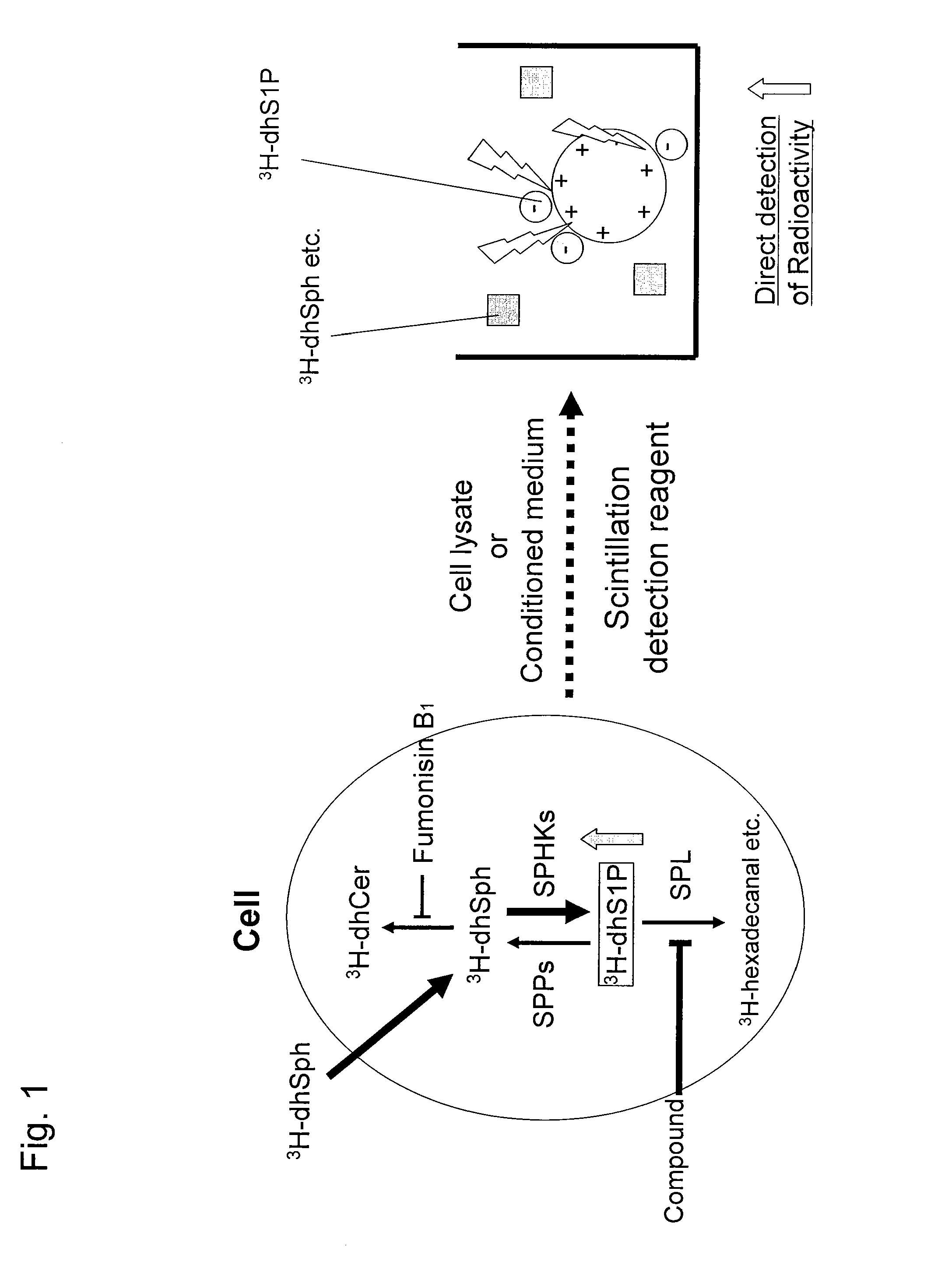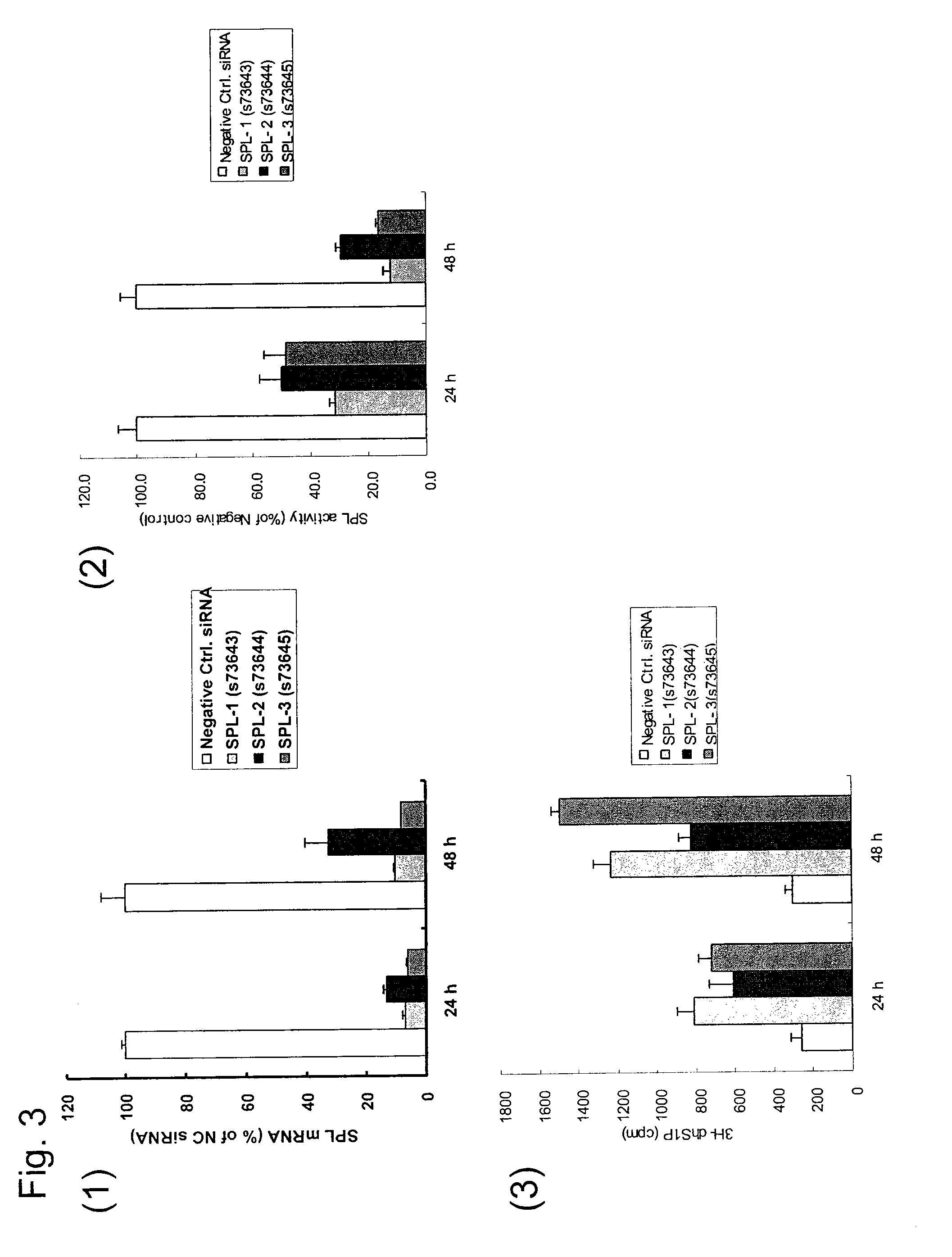Method for screening for S1P lyase inhibitors using cultured cells
a lyase inhibitor and cultured cell technology, applied in the field of high-speed multiple sample screening for an s1p lyase inhibitor, can solve the problems of low sample processing capability, no cell-based screening examples, and no inhibitor specific to spl, and achieve the effect of increasing the amount of s1p or dhs1p
- Summary
- Abstract
- Description
- Claims
- Application Information
AI Technical Summary
Benefits of technology
Problems solved by technology
Method used
Image
Examples
example 1
Detection of 3H-dhS1P by SPA
[0062]3H-dhS1P (60 Ci / mmol, American Radiolabeled Chemicals, ART 0618) or 3H-dhSph (60 Ci / mmol, American Radiolabeled Chemicals, ART 0460) was serially diluted with a cell lysis buffer (a mixed solution of IP-One Tb conjugate & lysis buffer and IP1 stimulation buffer (1×) (3:7) which are components of IP-One Tb Kit, manufactured by Cisbio, Inc.).
[0063]In order to examine the total radioactivity, 50 μL of each of the diluted solutions of the above 3H-labeled compounds was mixed with 5 mL of a liquid scintillator (Hionic-Fluor, PerkinElmer), and the radioactivity thereof was measured using a liquid scintillation counter (Aloka).
[0064]In order to examine the efficiency of a conventional separation extraction method, to 50 μmL of each of the diluted solutions of the above 3H-labeled compounds, 50 μL of a 0.2 M sodium hydroxide solution and 100 μL of a mixed solution of chloroform and methanol (chloroform: methanol=2:1) were added, and the resulting mixture wa...
example 2
Confirmation of Various Effects of siRNA Transfection
1) Cell Culture and Culture Media
[0067]A mouse thymic epithelial cell line (IT-79MTNC3 cells, The Cell Bank Division of Japan Health Sciences Foundation) was cultured using Dulbecco's Modified Eagle Medium (DMEM, Invitrogen) containing 10% fetal bovine serum (FBS) (DMEM-10% FBS) at 37° C. in the presence of 5% CO2. When the cells were used for transfection or assay, the cells were detached with 0.05% trypsin-EDTA (Invitrogen), followed by centrifugation, thereby collecting the cells. When the cells were treated with a compound or used for incorporating 3H-dhSph, DMEM containing 0.1% bovine serum albumin (BSA, Sigma) (DMEM-0.1% BSA) or vitamin B6 group-depleted Dulbecco's Modified Eagle Medium (VB6-free DMEM, Cell Science & Technology Institute, Inc.) containing 0.1% BSA (VB6-free DMEM-0.1% BSA) was used.
2) siRNA Transfection
[0068]To IT-79MTNC3 cells prepared at 1×106 cells / 100 μL with Nucleofector Solution L (Lonza), 200 pmol of o...
example 3
Measurement of SPL Activity Using Known Inhibitor
1) SPA Using Known SPL Inhibitor
[0074]In order to evaluate the activity of a test compound for accumulating 3H-dhS1P, IT-79MTNC3 cells were suspended in DMEM-10% FBS containing 25 μM fumonisin B1, and seeded in a 96-well plate for cell culture at 1×104 cells / well, and then cultured at 37° C. in the presence of 5% CO2 for a whole day and night. On the next day, the culture supernatant was first removed, and then, 40 μL of DMEM-0.1% BSA (or VB6-free DMEM-0.1% BSA) containing a serially diluted test compound was added thereto, and the cells were cultured at 37° C. in the presence of 5% CO2 for 4.5 hours. Thereafter, 10 μL of DMEM-0.1% BSA (or VB6-free DMEM-0.1% BSA) containing 83 nM 3H-dhSph and 5 μM dhSph was added thereto, and the cells were cultured at 37° C. in the presence of 5% CO2 for 30 minutes. After the culture supernatant was removed, 70 μL of a cell lysis buffer was added thereto, and the resulting mixture was left at room te...
PUM
| Property | Measurement | Unit |
|---|---|---|
| pH | aaaaa | aaaaa |
| time | aaaaa | aaaaa |
| energy | aaaaa | aaaaa |
Abstract
Description
Claims
Application Information
 Login to View More
Login to View More - R&D
- Intellectual Property
- Life Sciences
- Materials
- Tech Scout
- Unparalleled Data Quality
- Higher Quality Content
- 60% Fewer Hallucinations
Browse by: Latest US Patents, China's latest patents, Technical Efficacy Thesaurus, Application Domain, Technology Topic, Popular Technical Reports.
© 2025 PatSnap. All rights reserved.Legal|Privacy policy|Modern Slavery Act Transparency Statement|Sitemap|About US| Contact US: help@patsnap.com



